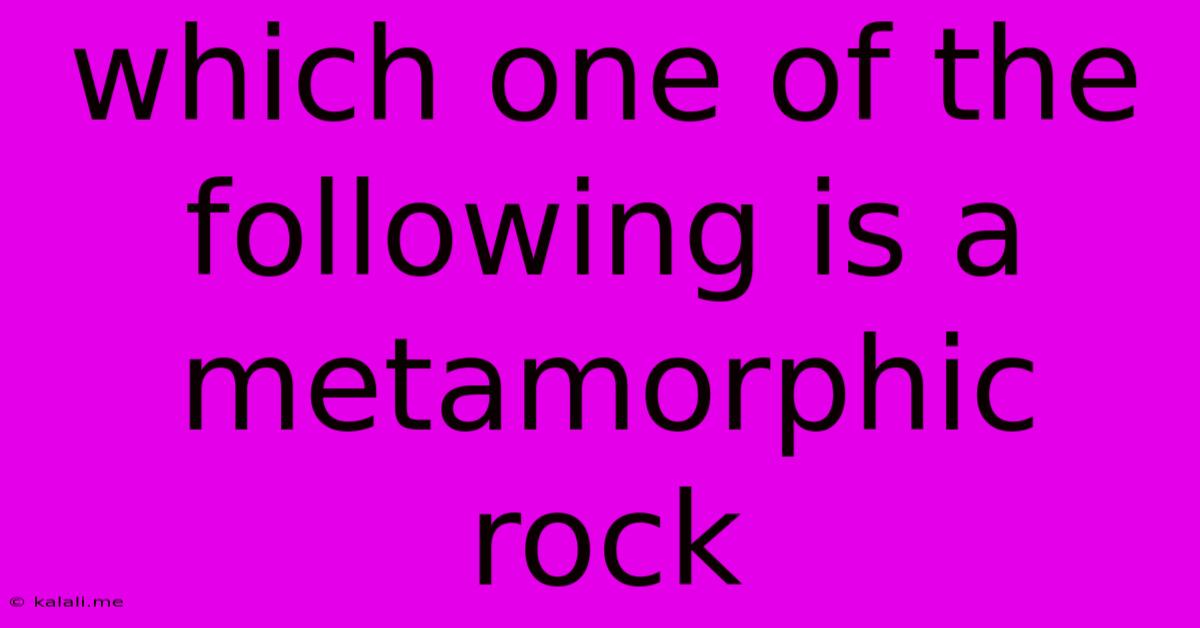Which One Of The Following Is A Metamorphic Rock
Kalali
Jun 13, 2025 · 3 min read

Table of Contents
Which One of the Following is a Metamorphic Rock? Understanding Metamorphic Rock Formation
Metamorphic rocks are fascinating formations resulting from the transformation of existing rocks under immense heat and pressure. This process, known as metamorphism, alters the original rock's mineral composition and texture without melting it. Understanding this process is key to identifying metamorphic rocks from other rock types like igneous and sedimentary rocks. This article will explore what defines a metamorphic rock and help you identify one from a list of options.
What is a Metamorphic Rock?
Metamorphism occurs deep within the Earth's crust where intense pressure and heat, often associated with tectonic plate movement, alter pre-existing rocks. These parent rocks can be igneous (formed from cooled magma), sedimentary (formed from compressed sediments), or even other metamorphic rocks. The resulting metamorphic rock's characteristics depend heavily on the parent rock's composition and the intensity of the metamorphic process. Key features of metamorphic rocks include:
- Foliation: A layered or banded texture resulting from the alignment of mineral crystals under directed pressure. This is a common characteristic, but not all metamorphic rocks exhibit it.
- Recrystallization: The growth of larger crystals from smaller ones due to increased heat and pressure.
- Mineral Changes: The formation of new minerals stable under the metamorphic conditions. This often involves changes in chemical composition.
Examples of Metamorphic Rocks:
Several common metamorphic rocks showcase the effects of metamorphism. These include:
- Marble: Formed from the metamorphism of limestone or dolostone. It's often characterized by its interlocking calcite crystals and can vary greatly in color and texture.
- Slate: Formed from the metamorphism of shale. It's known for its fine-grained texture and often displays excellent cleavage, splitting easily into thin sheets.
- Gneiss: A high-grade metamorphic rock typically formed from granite or other felsic igneous rocks. It's characterized by its banded texture with alternating layers of light and dark minerals.
- Schist: Formed from a variety of parent rocks and is characterized by its medium-to-coarse-grained texture and platy minerals like mica, giving it a schistosity (foliation).
- Quartzite: Formed from the metamorphism of sandstone, it is primarily composed of quartz and displays a hard, resistant nature.
Identifying a Metamorphic Rock from a List:
To determine which rock from a given list is metamorphic, consider the characteristics discussed above. Look for evidence of:
- Foliation (banding or layering): This is a strong indicator, although not all metamorphic rocks exhibit it.
- Recrystallization: Larger, interlocking crystals are a clue.
- Mineral assemblages: Certain minerals are more characteristic of metamorphic environments. The presence of minerals like garnet, staurolite, or kyanite can strongly suggest metamorphism.
Without a specific list of rocks to choose from, I cannot directly answer "Which one of the following is a metamorphic rock?". However, by using the characteristics and examples provided above, you should be able to easily identify a metamorphic rock from any list given. Remember to consider the rock's texture, mineral composition, and the presence of foliation when making your determination. Further research into specific rock types will strengthen your ability to accurately classify rocks.
Latest Posts
Latest Posts
-
Alexander Von Humboldt Contribution To Geography
Jun 13, 2025
-
What Can 26 Be Divided By
Jun 13, 2025
-
What Is The Shortcut For Save As
Jun 13, 2025
-
What Is The Smallest Particle Of Soil
Jun 13, 2025
-
How Many Megabytes Is 1 Tb
Jun 13, 2025
Related Post
Thank you for visiting our website which covers about Which One Of The Following Is A Metamorphic Rock . We hope the information provided has been useful to you. Feel free to contact us if you have any questions or need further assistance. See you next time and don't miss to bookmark.